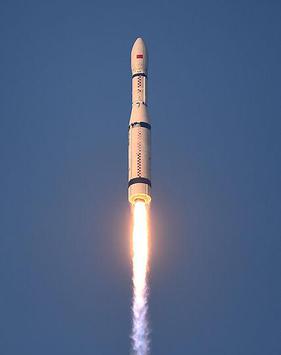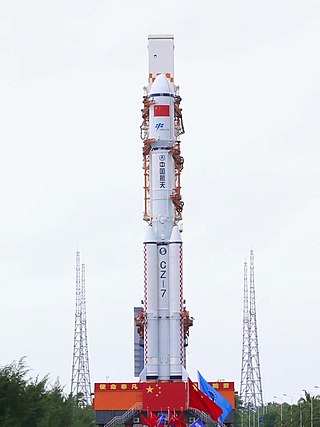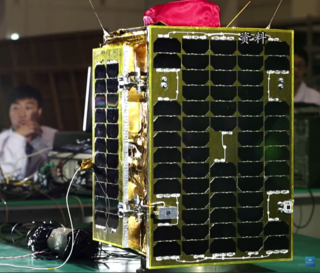Related Research Articles

The Long March 3A, also known as the Chang Zheng 3A, CZ-3A and LM-3A, is a Chinese orbital carrier rocket design. It is a 3-stage rocket, and is usually used to place communications satellites and Beidou navigation satellites into geosynchronous transfer orbits.
The Long March 1D was a member of China's Long March rocket family. During the 1990s CALT developed an improved version of the DF-4 to test the reentry vehicle warheads of the DF-31. They took advantage of this development and offered it as the Long March 1D for commercial application. The modifications included:
The Long March 2C (LM-2C), also known as the Chang Zheng 2C (CZ-2C), is a Chinese orbital launch vehicle, part of the Long March 2 rocket family. Developed and manufactured by the China Academy of Launch Vehicle Technology (CALT), the Long March 2C made its first launch on 9 September 1982. It is a two-stage launch vehicle with storable propellants, consisting of Nitrogen Tetroxide and Unsymmetrical Dimethylhydrazine. The launch vehicle was derived from the DF-5 ICBM.
The YF-77 is China's first cryogenic rocket engine developed for booster applications. It burns liquid hydrogen fuel and liquid oxygen oxidizer using a gas generator cycle. A pair of these engines powers the LM-5 core stage. Each engine can independently gimbal in two planes. Although the YF-77 is ignited prior to liftoff, the LM-5's four strap-on boosters provide most of the initial thrust in an arrangement similar to the European Vulcain on the Ariane 5 or the Japanese LE-7 on the H-II.

The YF-100 is a Chinese liquid rocket engine burning LOX and kerosene in an oxidizer-rich staged combustion cycle.

This comparison of orbital launch systems lists the attributes of all individual rocket configurations designed to reach orbit. A first list contains rockets that are operational or in development as of 2022; a second list includes all retired rockets. For the simple list of all conventional launcher families, see: Comparison of orbital launchers families. For the list of predominantly solid-fueled orbital launch systems, see: Comparison of solid-fueled orbital launch systems.
The Long March 3B, also known as the CZ-3B and LM-3B, is a Chinese orbital launch vehicle. Introduced in 1996, it is launched from Launch Area 2 and 3 at the Xichang Satellite Launch Center in Sichuan. A three-stage rocket with four strap-on liquid rocket boosters, it is currently the second most powerful member of the Long March rocket family after the Long March 5 and the heaviest of the Long March 3 rocket family, and is mainly used to place communications satellites into geosynchronous orbits.
The Long March 3C, also known as the Changzheng 3C, CZ-3C and LM-3C, is a Chinese orbital launch vehicle. It is launched from Launch Complex 2 and 3 at the Xichang Satellite Launch Center (XSLC). A three-stage rocket with two strapon liquid rocket boosters, it is a member of the Long March 3 rocket family, and was derived from the Long March 3B. It was designed to fill a gap in payload capacities between the Long March 3A and 3B.

The Long March 6 or Chang Zheng 6 as in pinyin, abbreviated LM 6 for export or CZ 6 within China, is a Chinese liquid-fuelled launch vehicle of the Long March family, which was developed by the China Aerospace Science and Technology Corporation (CASC) and the Shanghai Academy of Spaceflight Technology (SAST). The rocket was developed in the 2000s, and made its maiden flight in 2015. As one of the new generation rocket family, the Long March 6 was designed to be a light capacity, "high-speed response" rocket, complementing the heavy lift Long March 5 and the mid-heavy lift Long March 7 rocket families. It is capable of placing at least 1,000 kg (2,200 lb) of payload into a Sun-synchronous orbit. The first stage of the Long March 6 was derived from the booster rockets being developed for the Long March 5 rocket. It is powered by a YF-100 engine, which generates 1,340 kN (300,000 lbf) of thrust from burning kerosene and LOX as rocket fuel and oxidiser. This was the first flight of the new engine design.

The Long March 7, or Chang Zheng 7 in pinyin, abbreviated LM-7 for export or CZ-7 within China, originally Long March 2F/H or Chang Zheng 2F/H, nicknamed Bingjian, is a Chinese liquid-fuelled launch vehicle of the Long March family, developed by the China Aerospace Science and Technology Corporation (CAST). It made its inaugural flight on 25 June 2016.
The RD-120 is a liquid upper stage rocket engine burning RG-1 and LOX in an oxidizer rich staged combustion cycle with an O/F ratio of 2.6. It is used in the second stage of the Zenit family of launch vehicles. It has a single, fixed combustion chamber and thus on the Zenit it is paired with the RD-8 vernier engine. The engine has been developed from 1976 to 1985 by NPO Energomash with V.P. Radovsky leading the development. It is manufactured by, among others, Yuzhmash in Ukraine.
The YF-75D is a liquid cryogenic rocket engine burning liquid hydrogen and liquid oxygen in a closed expander cycle. It is China's third generation of upper stage cryogenic propellant engine, after the YF-73 and the YF-75. It is used in a dual engine mount in the H5-2 second stage of the Long March 5 launch vehicles. Within the mount, each engine can gimbal individually to enable thrust vectoring control. As its predecessor, the YF-75 it can adjust its mixture ratio to optimize propellant consumption. But as an additional improvement, it can do multiple restarts, against the single one of its predecessor.
The YF-40 is a Chinese liquid rocket engine burning N2O4 and UDMH in a gas generator cycle. It has dual gimbaling combustion chambers.
The CTS is an upper stage developed by the China Academy of Launch Vehicle Technology (CALT) to improve the performance of the Long March 2C to high LEO missions like SSO. The two stage LM-2 delivers the payload and stage to an elliptical orbit with the desired apogee and the CTS points the stack in the direction of the correct vector and activates the solid rocket motor (SRM) main engine to circularize it. It then dispenses the spacecraft and does a passivisation procedure.
The YF-1 was a Chinese liquid rocket engine burning N2O4 and UDMH in a gas generator cycle. It is a basic engine which when mounted in a four engine module forms the YF-2. It was used as the basis for developing a high altitude version known as the YF-3.
The FG-36 was a Chinese spin stabilized apogee kick motor burning HTPB. It was developed by China Hexi Chemical and Machinery Corporation for use in the Fengyun 2 satellite bus for insertion into GSO orbit.

Jilin-1 is China's first self-developed commercial remote sensing satellite system. The satellites are operated by Chang Guang Satellite Technology Corporation and named after Jilin Province where the company is headquartered. The first set of satellites were launched by Long March 2D in Jiuquan Satellite Launch Center on 7 October 2015, at 04:13 UTC. All launched Jilin-1 satellites are in sun-synchronous orbit (SSO).
The YF-130 is a Chinese rocket engine fueled by LOX and kerosene in an oxidizer-rich staged combustion cycle currently in development. It has been designed to reach around 500 tonnes of thrust and it will power the super heavy Long March 9 rocket.
The YF-79 is a liquid cryogenic rocket engine burning liquid hydrogen and liquid oxygen in a closed expander cycle. It is China's fourth generation of upper stage cryogenic propellant engine, after the YF-73, YF-75 and the YF-75D. It can do multiple restarts thanks to an electric spark igniter and a prototype was tested at 60% and 100% thrust levels in December 2021.
The Long March 6A or Chang Zheng 6A as in pinyin, abbreviated LM 6A for export or CZ 6A within China, is a Chinese launch vehicle of the Long March family, which was developed by the China Aerospace Science and Technology Corporation (CASC) and the Shanghai Academy of Spaceflight Technology (SAST). The vehicle is a further development of the Long March 6, with 2 YF-100 engines on the first stage as opposed to 1 on the Long March 6, augmented by 4 solid rocket boosters. The Long March 6A is China's first rocket with solid rocket boosters. The maiden launch of the Long March 6A took place 29 March 2022, successfully reaching orbit. It was also the first launch from the newly built launch complex 9A in Taiyuan.
References
- ↑ "采用了什么新技术吗?20颗微小卫星送入预定轨道!_参考消息_太行军事网". www.thjunshi.com (in Chinese). Retrieved 2016-04-11.
- 1 2 Gunter Dirk Krebs. "CZ-6 (Chang Zheng-5)". Gunter's Space Page. Retrieved 2015-07-02.
- 1 2 Gunter Dirk Krebs. "CZ-7 (Chang Zheng-5)". Gunter's Space Page. Retrieved 2015-07-02.
- 1 2 3 4 5 6 7 8 9 10 "中国新一代液氧煤油发动机3:YF100/115主要特性 - 深空网". www.shenkong.net (in Chinese). Archived from the original on 2016-03-04. Retrieved 2016-04-11.
- 1 2 "Chang Zheng-5 (Long March-5)". SinoDefence. Archived from the original on 2015-07-03. Retrieved 2015-07-02.
- 1 2 "Chang Zheng-6 (Long March-6)". SinoDefence. Retrieved 2015-07-02.
- 1 2 "Chang Zheng-7 (Long March-7)". SinoDefence. Retrieved 2015-07-02.
- ↑ "长征七号火箭发动机抽真空系统顺利通过试验 (Long March 7 rocket engine system passes vacuum test)" (in Chinese). CASC . Retrieved 2015-07-02.
